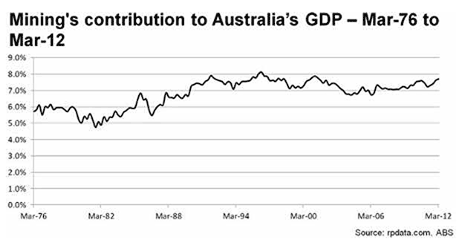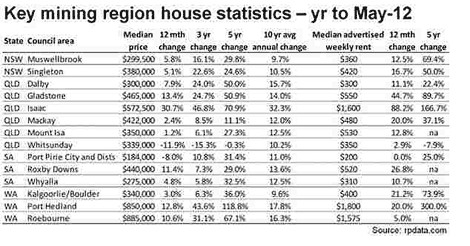Property ownership contributes more to Australia's GDP than mining: Cameron Kusher
According to the recently released National Accounts data for March 2012, mining activity accounted for 7.7% of the country’s Gross Domestic Product (GDP).
Although this may not sound overly significant, the only other items that contributed a greater amount to overall GDP were: financial and insurance services (9.8%), ownership of dwellings (8%) and construction (7.8%). Note that ownership of dwellings is reflective of the value of all dwellings plus other items, including agency fees, repairs and maintenance, loan application fees and other miscellaneous expenses.
Despite the fact that mining accounts for 7.7% of Australia’s economic growth, employment data from May 2012 shows that only 2.4% of Australians are employed in mining. Of course the number is likely higher when you consider services with links to mining. However, it is clear that the size of the workforce is not commensurate with the sectors current importance to economic growth.
Click to enlargeThe first chart shows that despite the magnitude of the current mining and resources boom, mining’s overall contribution to GDP has changed very little over the past 25 years.
Based on this figure it is clear that the mining sector is currently a very important component of Australia’s economic growth and intertwined with that is the importance of the housing sector, with ownership of dwellings accounting for 8% of GDP.
Across the housing market a majority of regions detailed have recorded an increase in median selling prices over the past 12 months. In the most extreme example, median selling prices have risen by 30.7% over the year across the Isaac council area, which takes in much of Queensland’s Bowen Basin. The Whitsunday region, including the towns of Bowen and Port Pirie, is the only region that has recorded a decline in median selling price.
Over the past 10 years all regions except Muswellbrook (9.7% pa) and Kalgoorlie/Boulder (9.6% pa) have recorded average annual growth in median selling price in excess of 10%pa. Once again, Isaac is the standout with median prices increasing at an average annual rate of 32.3%.
Rental rates have also shown robust growth over recent times, highlighting the impact that a lack of new housing supply can have on some of the boom mining towns. Rents have increased over the past year across each region except Port Pirie and have risen by 88.2% across the Isaac council region.
Click to enlarge Across the unit market there is typically a much lower supply of properties in these mining regions than there is for detached houses. While most of the council areas detailed recorded an increase in median house price over the year, median unit prices fell or were unchanged in nine of the 14 regions detailed. Despite the typically sluggish growth in prices over the past year, most have recorded strong increases over the past 10 years, albeit not typically as strong as the growth in house prices.
Unit rental rates have generally recorded quite strong increases over the past 12 months across the regions. This is likely due to the fact that unit rents are typically cheaper than those of detached houses and with many companies becoming more conscious of the costs associated with housing mining employees they are looking for more affordable alternatives such as units.
Click to enlarge
Overall, many of the major regions linked to the mining and resources sector have recorded increases in both median sales prices and rental rates over the year. With commodity prices seeming to have recently peaked, based on the RBA Commodity Price Index prices are down by 9.8% from their peak. Despite the recent fall, thanks to the surge in commodity prices since early 2009, the index remains 13.2% above the previous September 2008 peak. Whether the fall away in prices is enough to dampen the sector is yet to be seen.
Click to enlarge
A number of miners have already flagged that they are going to cut back on spending and some have already announced job losses. With the rate of growth in the Chinese economy slowing to a more sustainable pace it will be important to see what impact these factors have on mining communities over the coming year.
Cameron Kusher is senior research analyst at RP Data.
This article originally appeared on SmartCompany.
Photo of Parker Point loading facility Western Australia courtesy of Rio Tinto.




